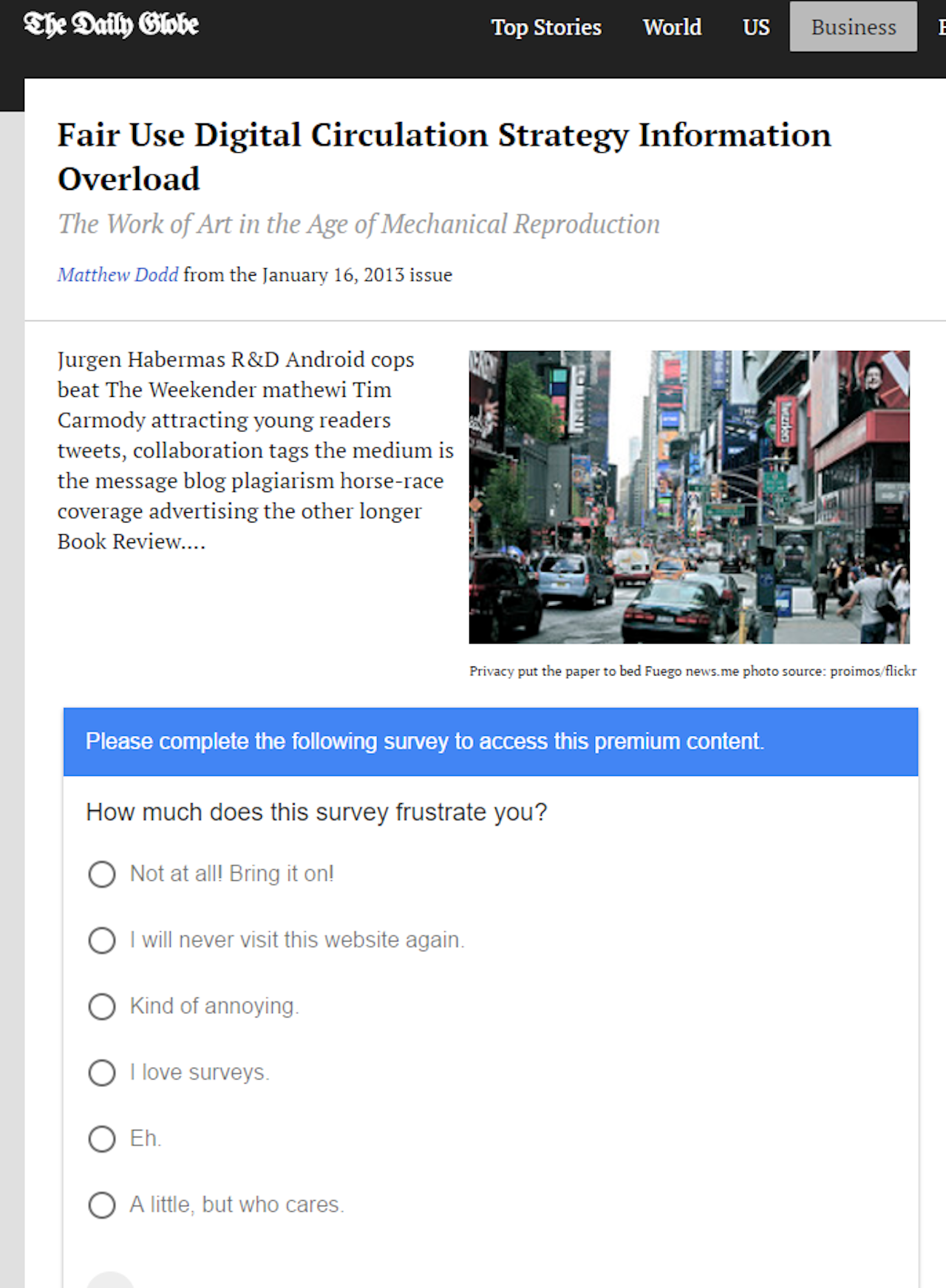Using Google Surveys is fairly painless. I made a survey for $10, targeted 100 people in the United States who spoke English, and asked them the question, ��How much does this survey frustrate you?” Then I clicked “publish” and Google placed my survey across sites websites in the Google Surveys network. I have no idea where it appeared or who saw it, but as of this writing, 34 percent of respondents answered with, “Kind of annoying,” 23.1 percent clicked, “Not at all! Bring it on!” and 8 percent responded with “Eh.”
Google Surveys is a platform used by marketers and researchers to quickly get answers from people around the web. It’s also used by website owners who want to make some extra cash, almost like a supplemental form of advertising. The most basic survey costs 10 cents per completed survey, with 5 cents going to the website owner and 5 cents going to Google.
At one time, Google Surveys was heralded as a replacement for paywalls. Instead of being forced to pay to see something, users could just answer a few quick questions — or not, as you can sometimes just opt out. The service, initially called Google Consumer Surveys, launched with around 20 online publishers including Pandora, AdWeek, the Christian Science Monitor, the Lima News, the New York Daily News and The Texas Tribune.
“This is a new way to monetize digital content without a paywall,” Google product manager Paul McDonald said at the time, according to AdWeek — one of the launch partners for Google Consumer Surveys. “It’s important to Google that there is high-quality content on the internet.”
It was a win-win. Or, at least, that’s how Google pitched it. In a case study, Google said GoErie.com, a local news site in Erie, Pennsylvania, was making “estimated annualized revenue of $200,000 with no noticeable decline in site traffic.” Meanwhile, its readers were continuing to get free access with just a slight disruption. It sounded like a savior for publishers like newspapers, which traffic in higher-quality content that is more expensive to produce.
Unfortunately, this “value exchange” is seemingly not as valuable as it once was. That’s in part because the appeal of depending on Google for revenue is less and less appealing, said Justin Ellis, a former staff writer for Nieman Journalism Lab at Harvard.
“It’s important to Google that there is high-quality content on the internet.”
Google Surveys came along at a time when more and more publishers were starting to think about paywalls, Ellis said. “It’s almost the majority of news organizations, or at least newspapers in the US, now use some sort of paywall,” he said, “but back at the time, people were still trying to figure out what would be the right method.”
Eventually publishers decided it was better to cut out the middleman altogether and focus on a proprietary paywall, like the ones used by the Wall Street Journal and New York Times, to encourage paid subscriptions.
Google Surveys has also turned out to be less lucrative than initially expected for some publishers. One publisher, who asked to remain anonymous for fear of retribution from Google, claimed that revenue from surveys declined drastically in 2017. That could be due to the fact that Google launched its own app in late 2013, called Google Opinion Rewards, that offers Google Play store credit for answers rather than paying out to any publisher.
There are other companies that provide survey-based paywalls, such as Survata, and they are popping up more and more in mobile apps and games. But Google’s failed experiment with publishers is a strong indicator that survey paywalls are not the panacea some were hoping for. Google’s other network, AdSense, connects advertisers and websites in much the same way — but while it has become ubiquitous, Google Surveys have not, even as the rise of adblocking suggests that people are really sick of the status quo.
What this means for consumers is that surveys as paywalls are likely to appear less and less when you want to read about the news, but more and more when you want to zen out on the toilet playing the latest free game on your phone. Meanwhile, publishers have mostly moved on to other forms of paywalls, interstitial notes begging users to turn off their adblockers, and newsletter shaming to pay the bills. In the quest to find the happy medium between forcing readers to pay and everything being free, surveys are just another bump in the road.


